What was Japan like in the 50s? How did people dress on the streets? How have Japanese cities changed since then? And what novelties and events shocked the inhabitants of this amazing country at that time? Well, we have the opportunity to go back in time and look at Japan in the 50s.
(32 photos in total)
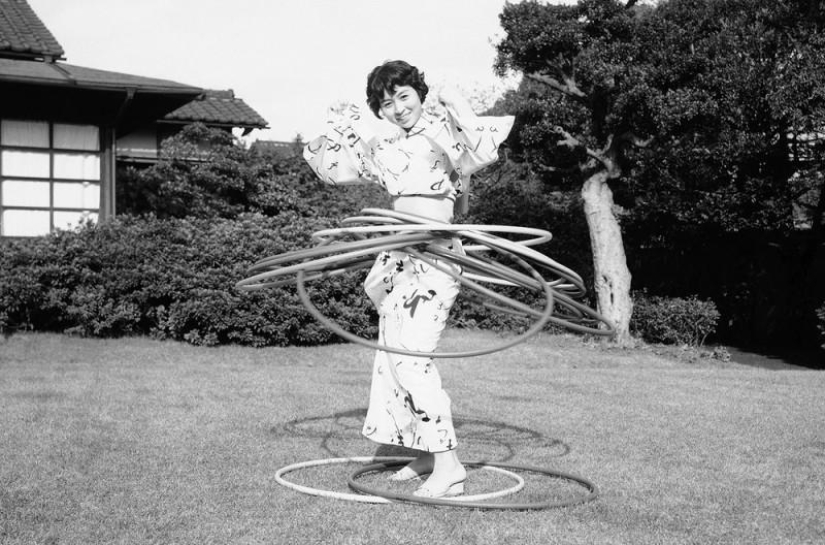
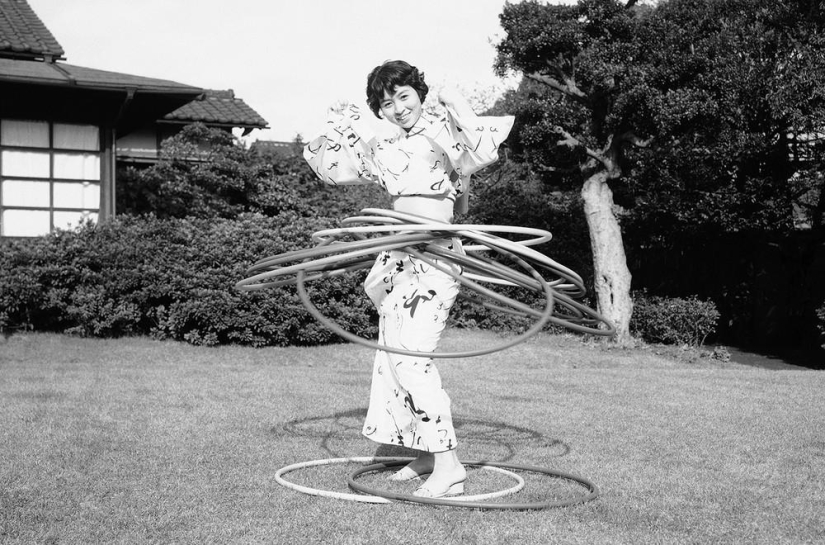
1. A Japanese girl in a kimono could not resist the "hula hoop madness" that swept America and Japan. The photo was taken on October 30, 1958. (Photo by Mitsunori Chigita/AP Photo via The Atlantic)
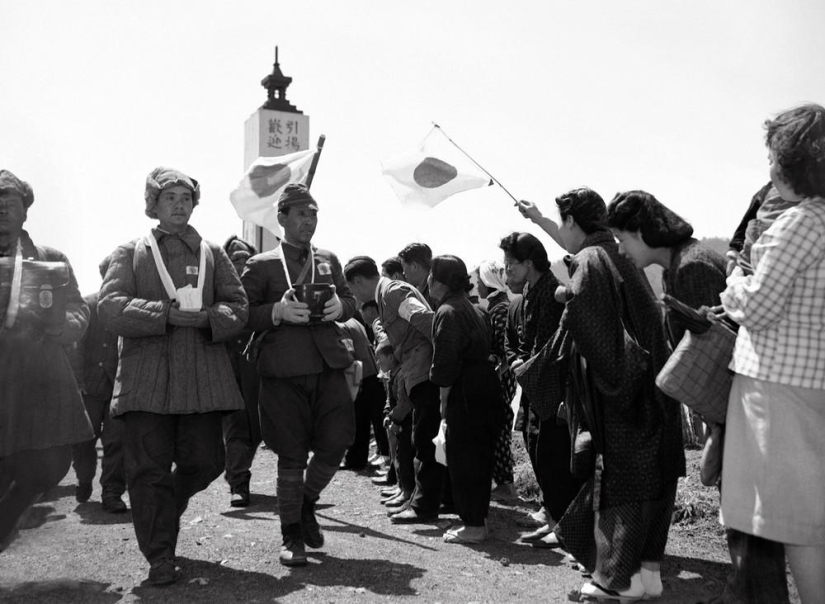
2. Women meet Japanese soldiers who returned home from captivity on April 26, 1950. Men carry the ashes of their fallen comrades. (Photo by AP Photo via The Atlantic)
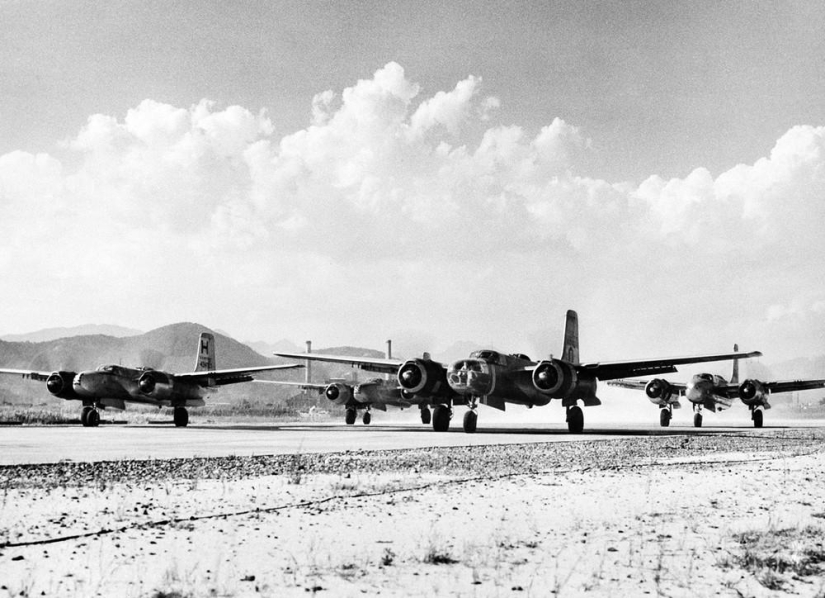
3. B-26 bombers are preparing to take off from the Far Eastern airfield in Japan on September 20, 1950 for combat missions in Korea. Twin-engine bombers provided round-the-clock support to the UN ground forces. (Photo by AP Photo/U.S. Air Force via The Atlantic)
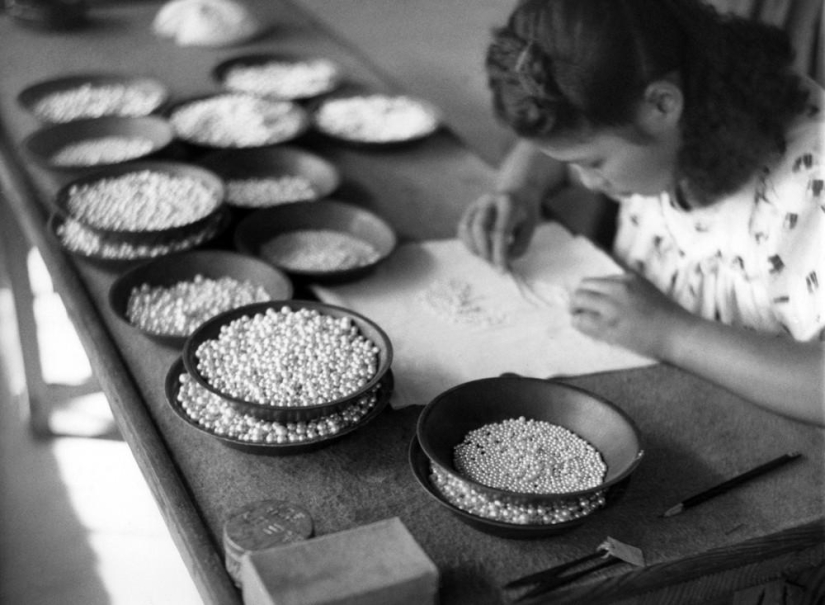
4. A girl carefully sorts pearls grown on the Kokichi Mikimoto farm, on the Ise Peninsula, October 12, 1949. At this stage, the pearls are sorted by color, size and shape. (Photo by AP Photo via The Atlantic)
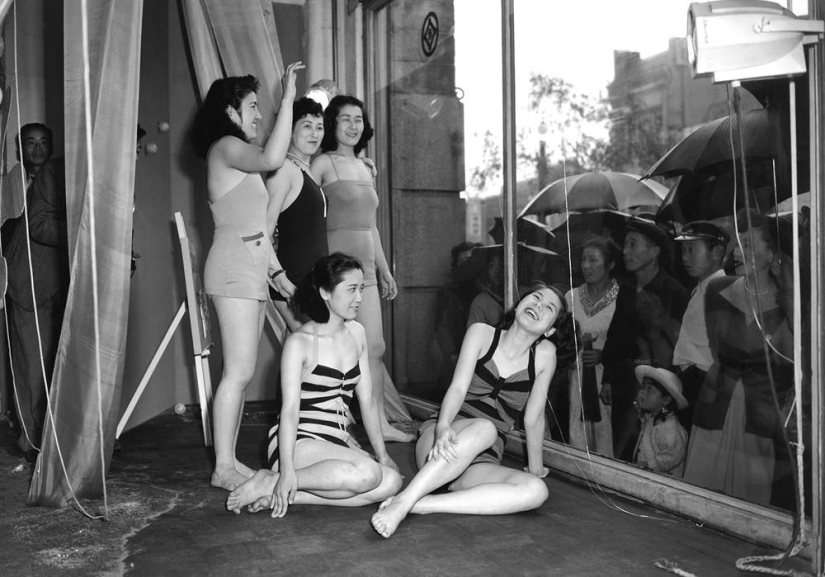
5. To attract public attention to the new line of swimwear, on June 5, 1950, a store in Tokyo used live models instead of mannequins. Even the rain did not stop curious passers-by, and it seems that both the girls and the audience liked the idea of looking at each other through the glass. (Photo by AP Photo via The Atlantic)
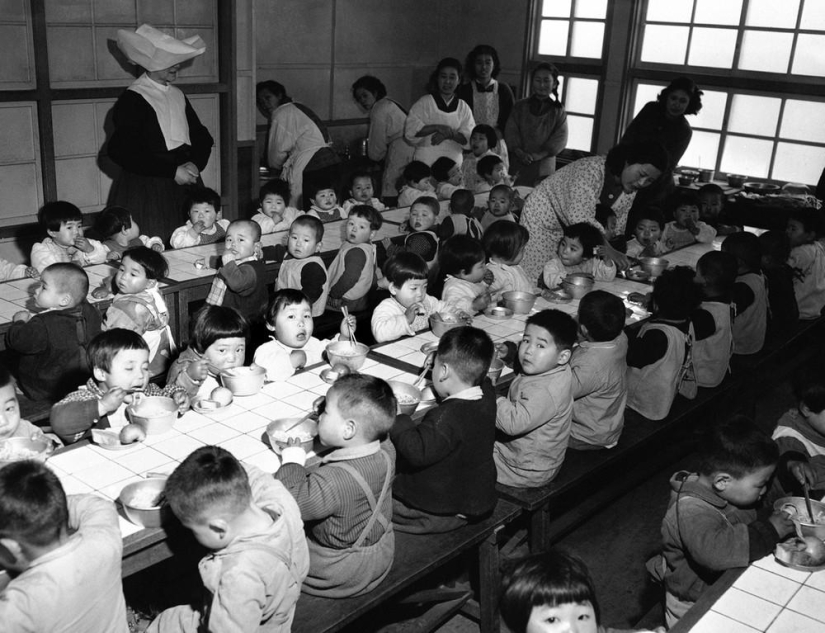
6. The dining room at the orphanage in Osaka on February 19, 1951. 160 orphans were fed here every day. The food was bought at the expense of the 27th Infantry Regiment of the US Army. (Photo by Jim Pringle/AP Photo via The Atlantic)
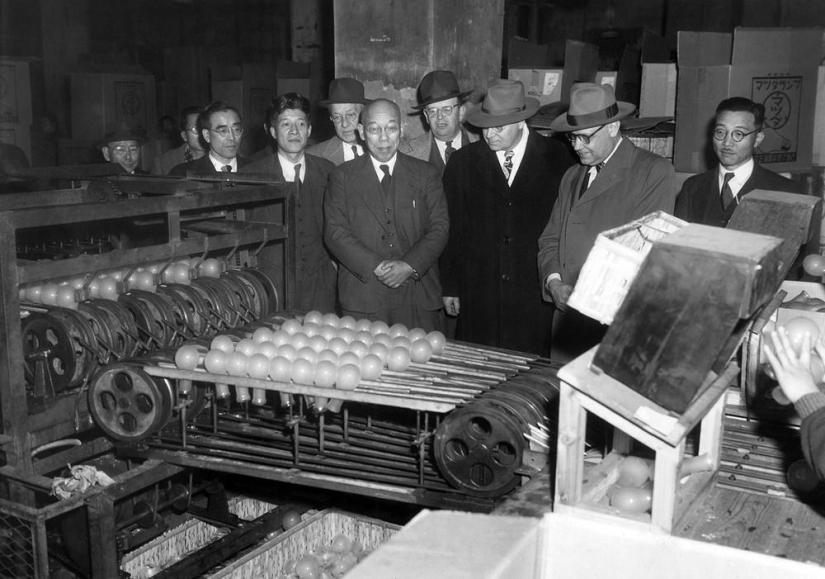
7. Production training experts watch as the machine drops the light bulbs down to another branch of the factory, where they are sorted manually, in Tokyo on January 25, 1951. (Photo by Arthur Curlis/AP Photo/U.S. Army via The Atlantic)
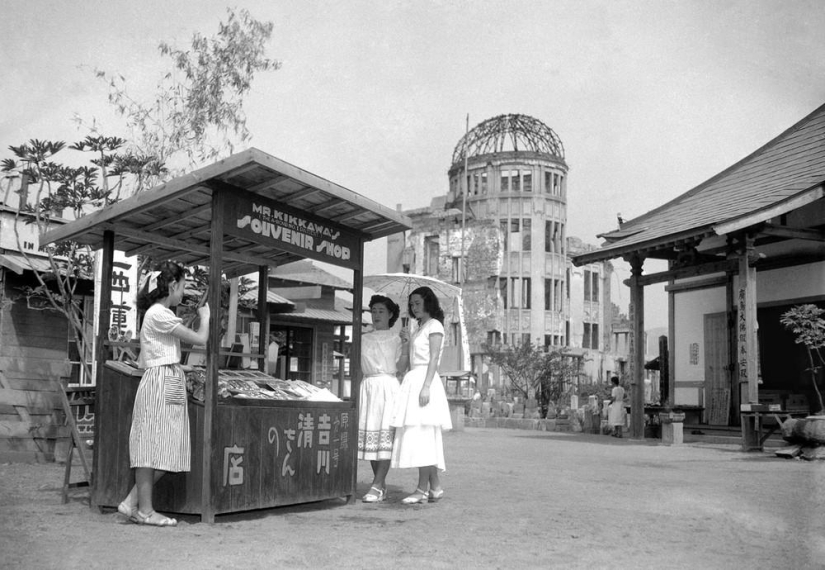
8. On August 3, 1951, six years after the atomic bomb explosion in Hiroshima, the girls stand next to a souvenir shop on the street next to the destroyed dome of the Industrial Hall. The owner of the shop, Kyoshi Yoshikawa, was injured in the explosion. (Photo by AP Photo/Kyodo via The Atlantic)
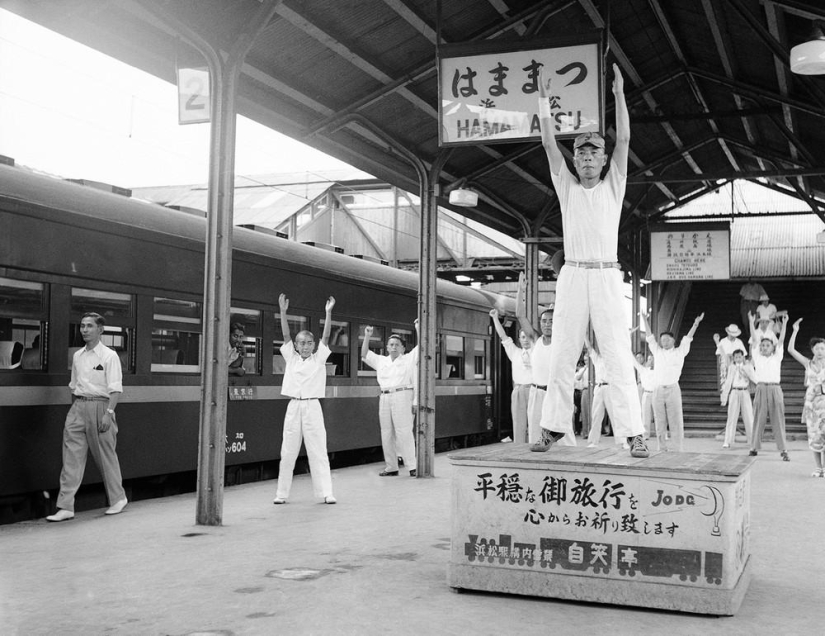
9. Passengers of the Tokyo-Osaka train during a three-minute gymnastics under the guidance of an instructor in Hamamatsu on August 27, 1952, where the train stopped for 5 minutes. This unusual service was organized in order to help passengers warm up during a long journey between the two cities. There was even a platform for an instructor and musical accompaniment at the station. (Photo by Max Desfor/AP Photo via The Atlantic)
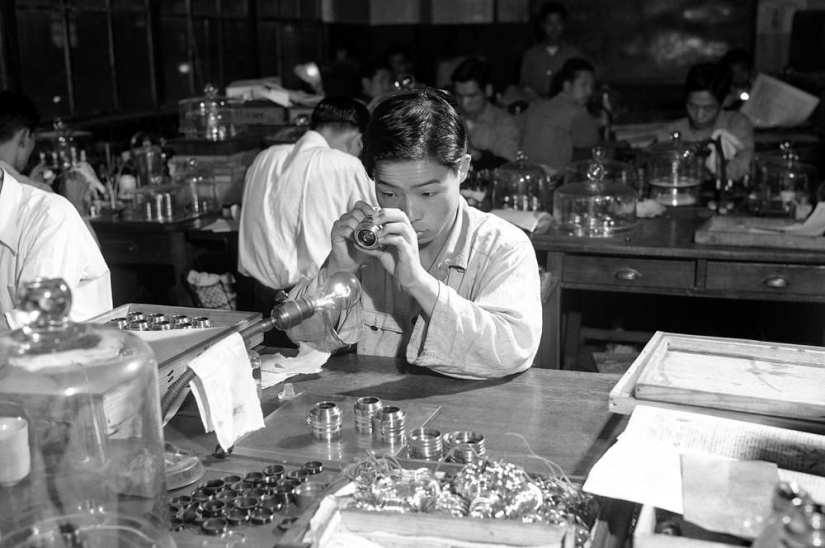
10. Inspection of the lens at the Tokyo camera factory on January 5, 1952. (Photo by Bob Schutz/AP Photo via The Atlantic)
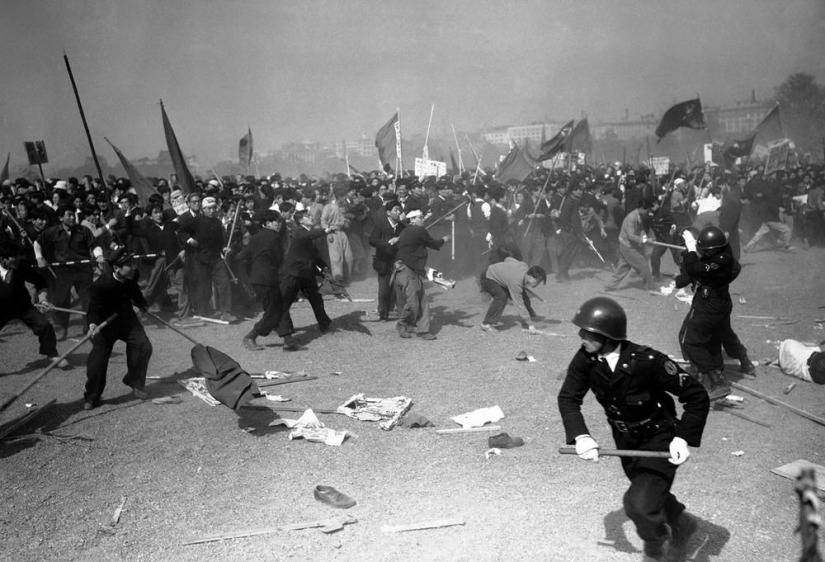
11. A clash between Communist demonstrators and Japanese police in central Tokyo on May 1, 1952. There were many casualties on both sides: the police used tear gas and batons. (Photo by Max Desfor/AP Photo via The Atlantic)

12. A bloodied young man is led out of the protest venue after a clash between police and demonstrators on May 1, 1952 in Tokyo. (Photo by AP Photo via The Atlantic)
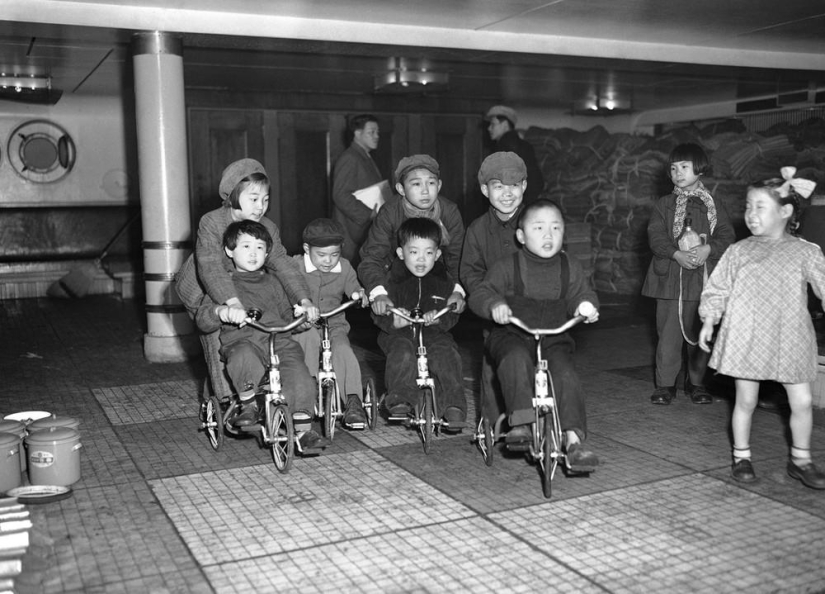
13. Children of Japanese families returning to their homeland play on the deck of the Koan Maaru ship during a trip in Maitsuru Bay on March 24, 1953. The first group of families returned from Communist China, where they had been since the end of World War II. It was only by 1953 that they were finally allowed to go home. The first group of 2,000 people arrived from Northern China to Koan Maaru. Bicycles were given to children by charitable organizations. (Photo by Y. Jackson Ishizaki/AP Photo via The Atlantic)
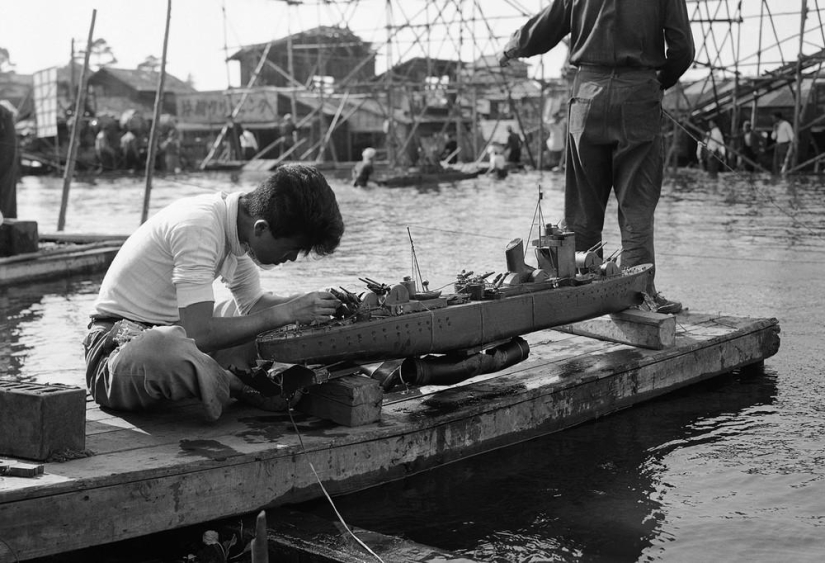
14. A film studio worker works on one of the ship models before filming a documentary about the Yamato warship on June 8, 1953. (Photo by Yuichi Ishizaki/AP Photo via The Atlantic)
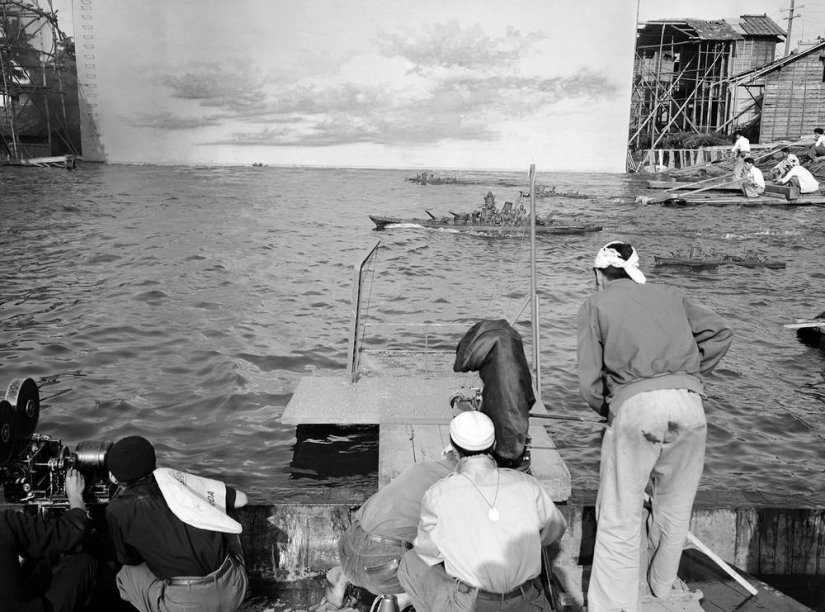
15. Filming of the film "Yamato" in the studio pool of the Japanese film company Shin-Toho on June 8, 1953. (Photo by Yuichi Ishizaki/AP Photo via The Atlantic)
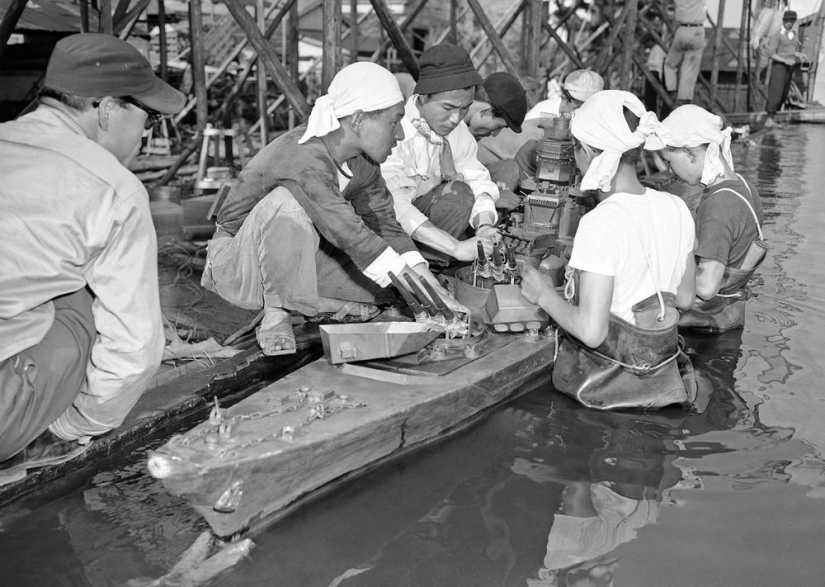
16. The last day of filming the documentary "Yamato". (Photo by Yuichi Ishizaki/AP Photo via The Atlantic)
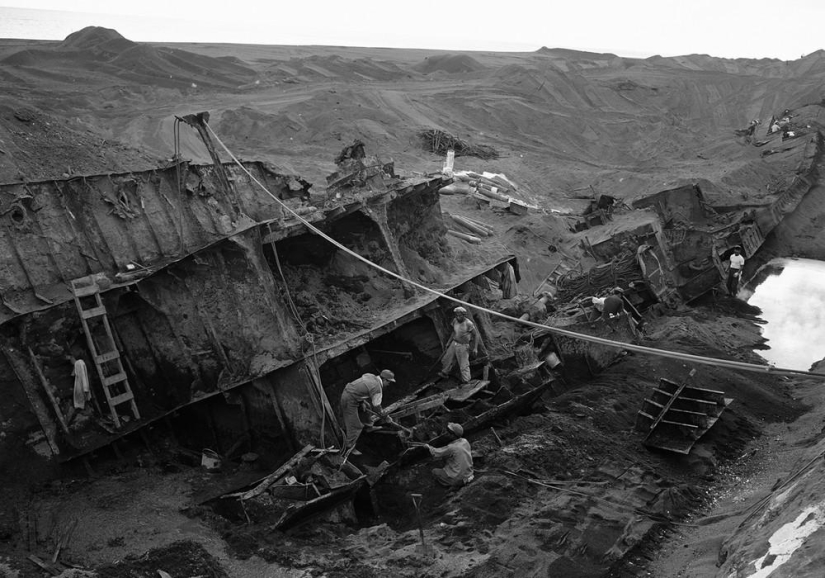
17. On the island of Io, Japanese workers dismantle the ship for scrap on February 21, 1954. After 9 years, the Japanese returned to the island of Io, but already as groups for dismantling ships. (Photo by AP Photo via The Atlantic)

18. Spectators with fans watch a baseball match between Waseda and Keio Universities in Tokyo on June 1, 1954. On the left, the Japanese leader of the support group cheers on the audience, whose fans are painted in the colors of a particular university. (Photo by AP Photo via The Atlantic)
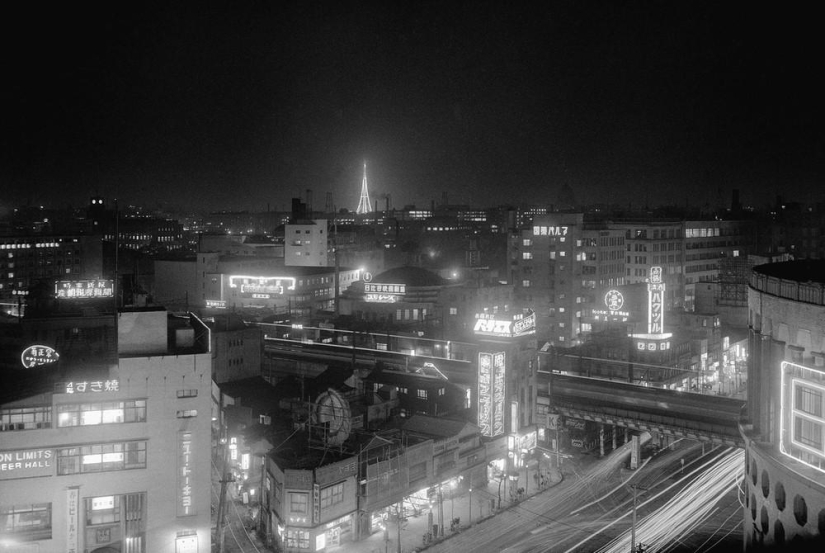
19. Ten thousand lights illuminate the new tower of the TV station in the center of Tokyo on March 26, 1955 during the largest flash shot in the world. Radio Tokyo, together with a local light bulb manufacturing company, has decorated its new 157-meter television antenna with 10,000 light bulbs as a promo for the opening of the channel on April 1. Thousands of photographers crowded on the upper floors and roofs of neighboring buildings to capture the event. (Photo by AP Photo via The Atlantic)
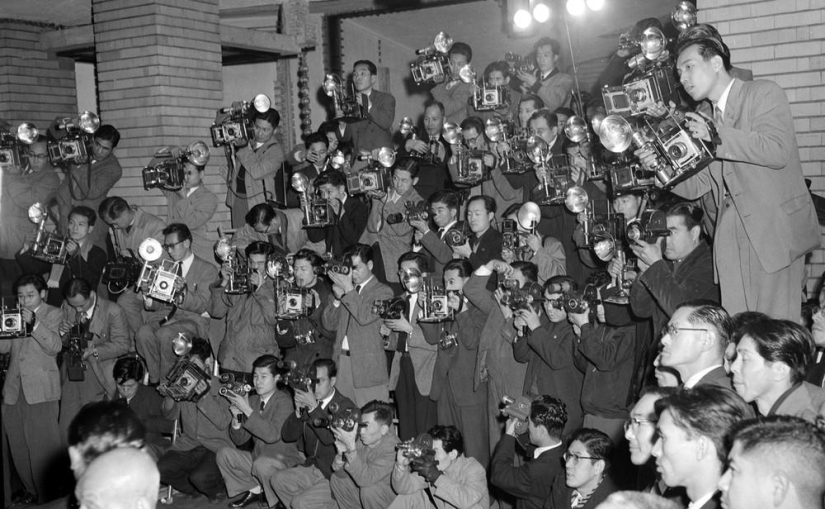
20. 45 cameramen and journalists photograph the new office of the Japanese Prime Minister in the center of Tokyo on December 17, 1954. Usually Japanese newspapers sent 3-4 photographers to report on the event in order to capture the event from all possible angles. (Photo by AP Photo via The Atlantic)

21. Nurses of the newly formed self-defense forces in Hokkaido, during maneuvers on October 20, 1955. Japanese forces went on military exercises against an imaginary enemy. (Photo by AP Photo via The Atlantic)
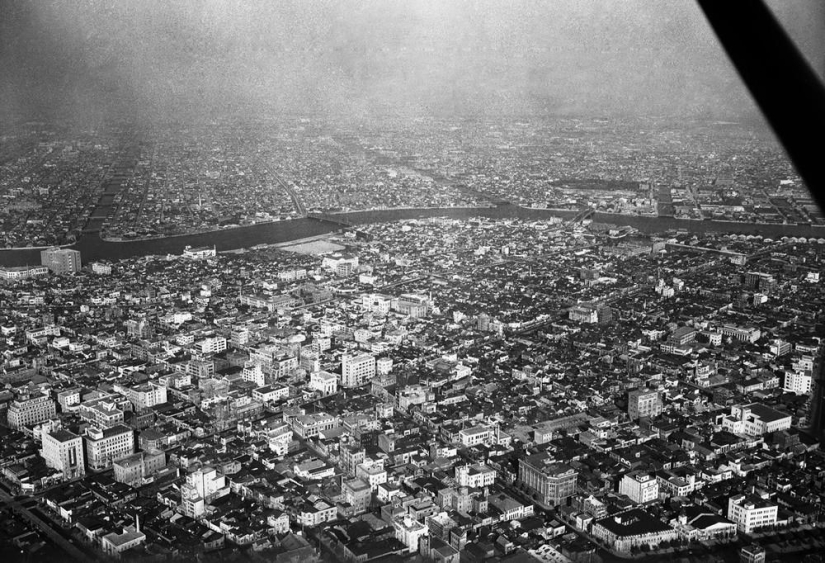
22. Tokyo from a height on August 5, 1955. Modern buildings are gradually filling the city blocks. The Sumida River flows peacefully through the Hamacho quarter (in the foreground) and Fukawaga County. Most of these areas are occupied by warehouses. (Photo by AP Photo via The Atlantic)
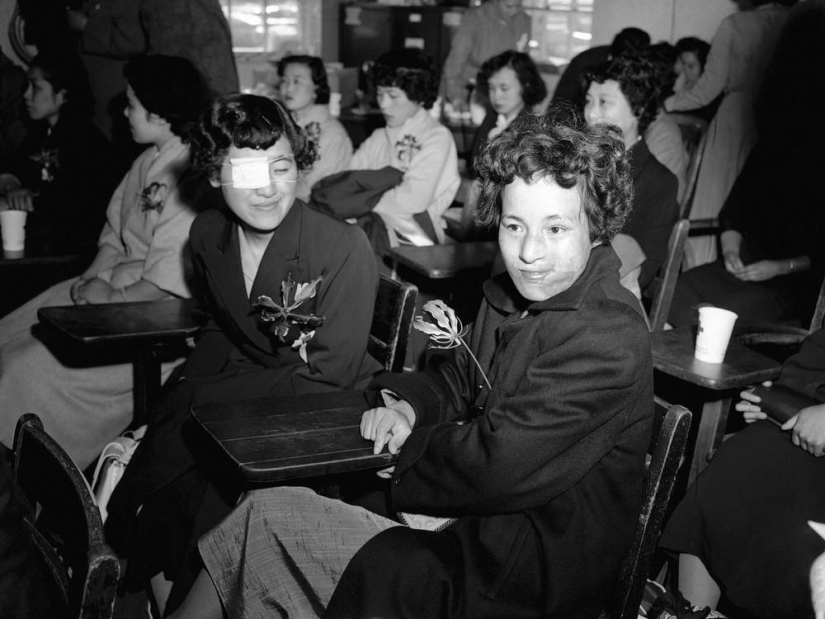
23. Japanese women Mitsuko Kuranoto (left) and Emiko Takemoto, who survived the nuclear attack in Hiroshima 10 years ago, sit at a military base in Long Island, New York, May 9, 1955. 25 Japanese women injured in the explosion arrived in New York hoping to have plastic surgery. (Photo by Jacob Harris/AP Photo via The Atlantic)
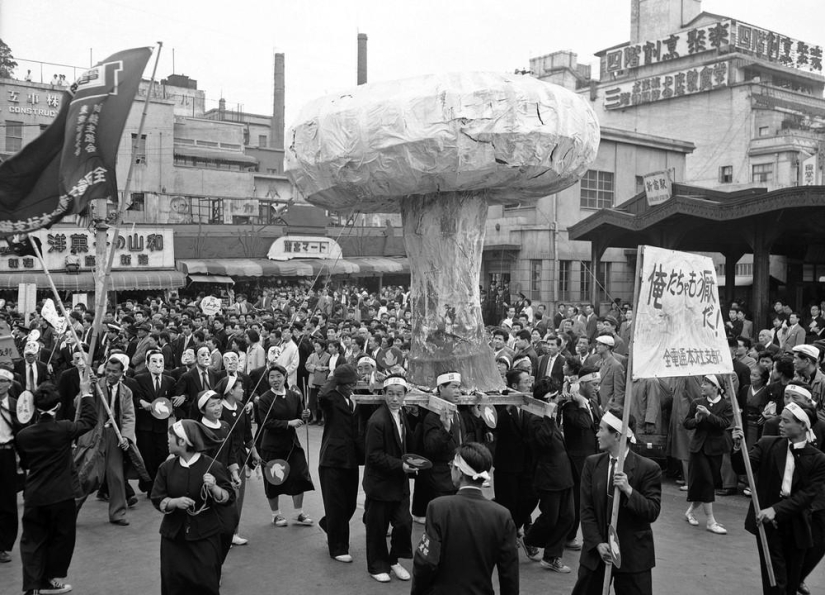
24. A huge copy of the atomic "fungus" is carried through the streets of Tokyo on May 1, 1957 in protest against the testing of the atomic bomb on Christmas Island. (Photo by AP Photo via The Atlantic)

25. Japanese Army volunteers during maneuvers at the Fuji Military School on May 15, 1957 near Tokyo. Armed with American weapons and supported by a US tank, the soldiers took part in intensive military exercises on land, sea and in the air. (Photo by George Sweers/AP Photo via The Atlantic)
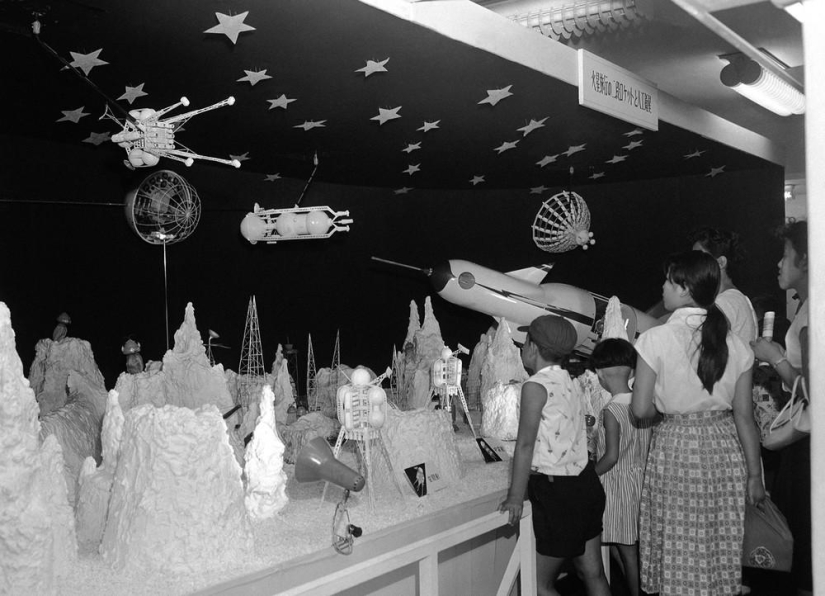
26. Japanese children view one of the models at an exhibition about "open space" in a Tokyo department store on August 19, 1958. Here they saw a rocket landing on the moon, strange inhabitants of the moon and even a satellite. (Photo by AP Photo via The Atlantic)
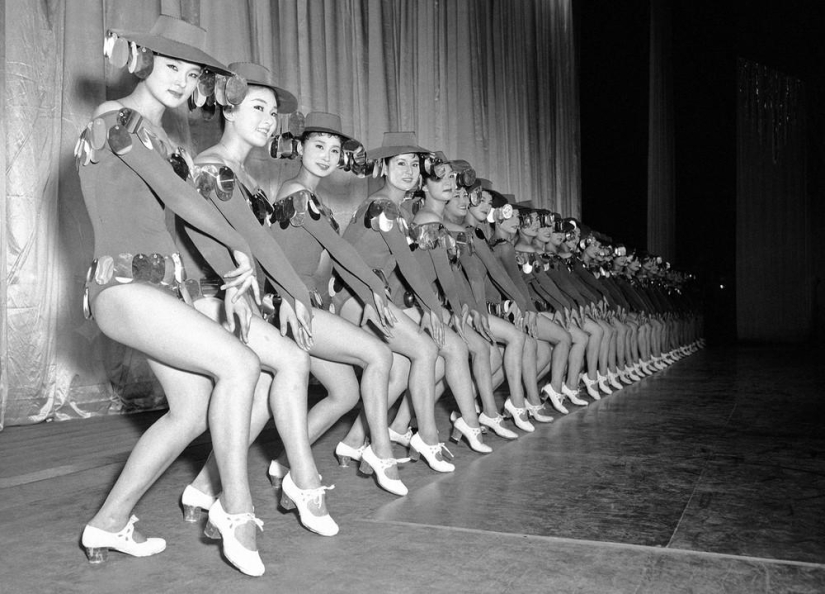
27. Japanese dancers of the Shochiku troupe rehearse one of their numbers at the summer school of the Kokusai Theater in Tokyo on July 11, 1958. (Photo by Mitsunori Chigita/AP Photo via The Atlantic)
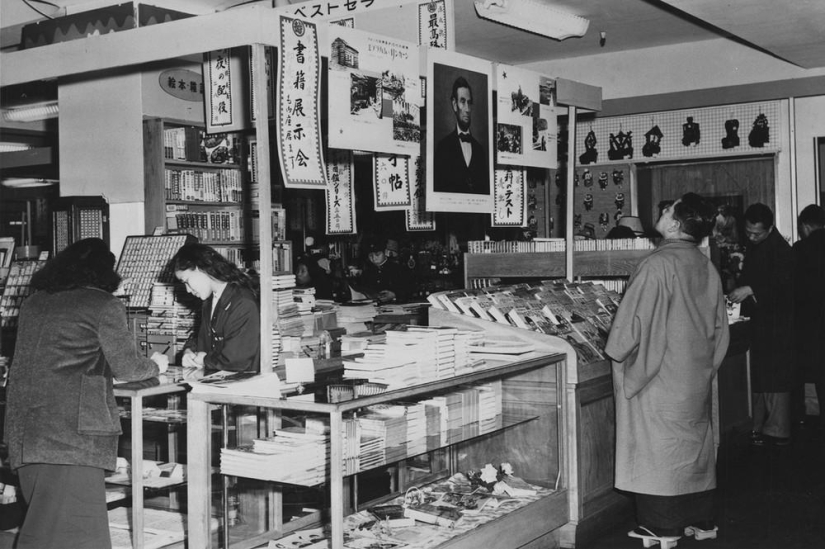
28. Tokyo department store in 1959, where a Japanese man in traditional wooden sandals examines a portrait of Abraham Lincoln. (Photo by Library of Congress via The Atlantic)
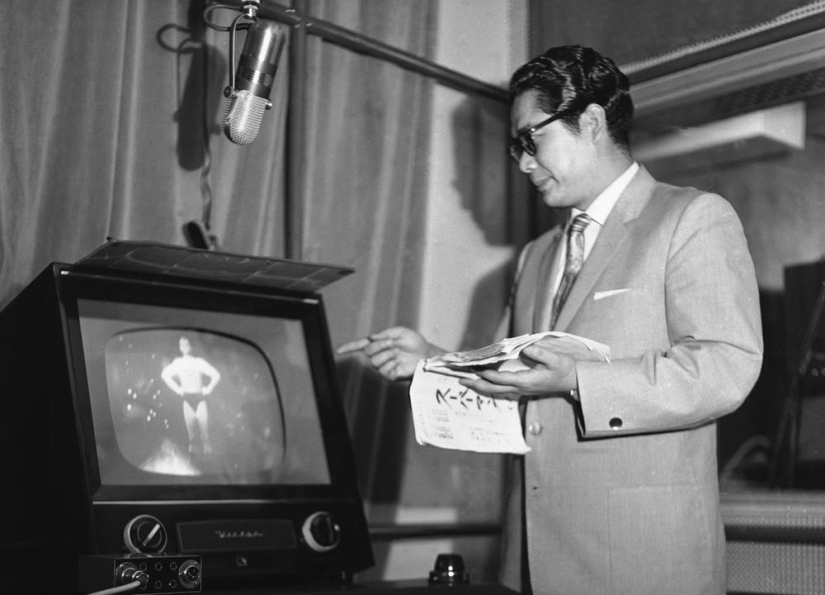
29. Turu Ohira, the Japanese "voice" of Superman, looks at actor George Reeves on the screen during the dubbing of the series on July 7, 1959. Television made a huge impression on the Japanese. In the 50s, about 99% of Japanese television was devoted to American shows, and "Superman" is one of the most beloved. (Photo by AP Photo via The Atlantic)
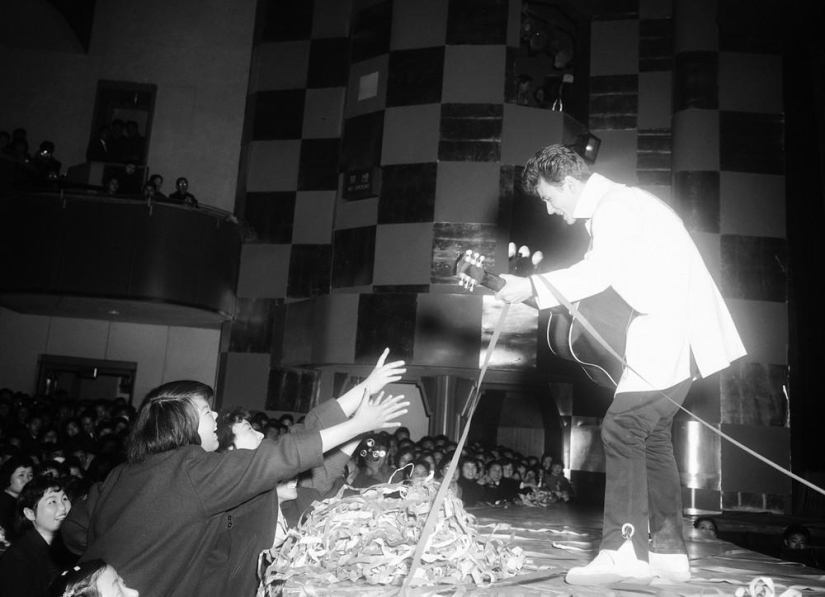
30. Mickey Curtis – singer in the style of Elvis Presley – at a concert at the Nichigeki Theater in Tokyo on February 18, 1958. Fans can't resist the urge to touch him. Japan was gripped by the madness of rock and roll. Screaming, moaning, applauding teenagers packed the theater to capacity. (Photo by AP Photo via The Atlantic)
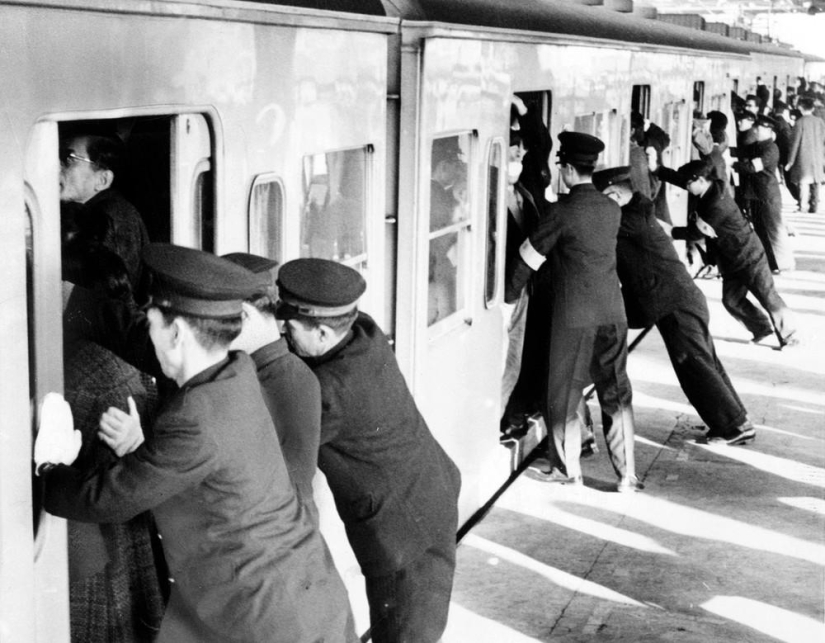
31. College students were hired to "tamp" passengers into cars in Tokyo. (Photo by Library of Congress via The Atlantic)
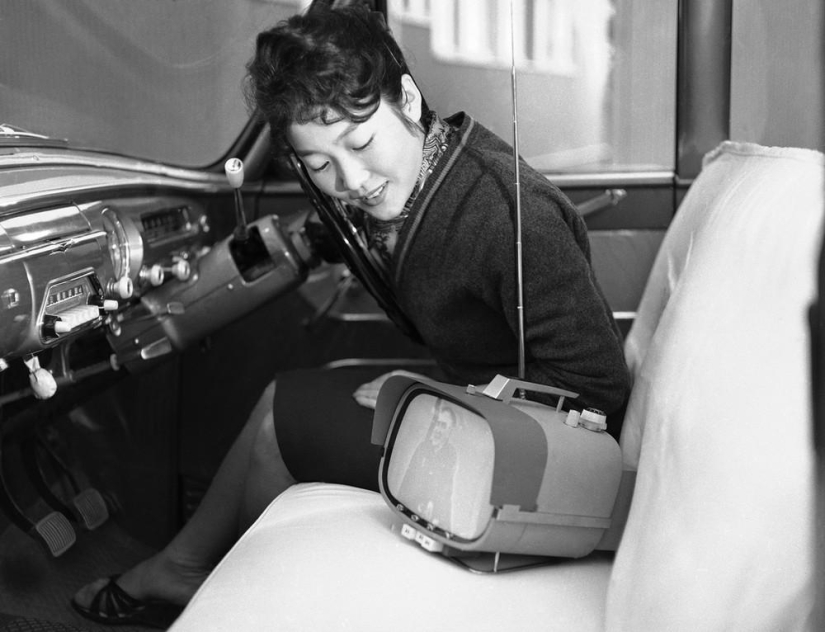
32. Tomiko Kawabata in his car admires his brand new transistor portable TV, which Sony has started producing. The picture was taken in Tokyo on January 5, 1960. The TV has an 8-inch screen (20 cm), it is powered by batteries, which last for three hours, as well as from a regular outlet. (Photo by AP Photo via The Atlantic)
Recent articles

Immunity to poisons at all times been the dream of all authority. List of popes, kings and emperors, gave his soul to God through ...

Sometimes even minor little things can make you angry and spoil your mood for the rest of the day. And even the most calm, balanced ...
Related articles

Yuuki Morita is a promising young sculptor and artist from Japan. The source of inspiration for him was nature, its diversity and ...

Beautiful decoration of dishes is no less important than its taste. People first "eat" with their eyes, and only then try what is ...

Japanese artist gives zest to the ancient engravings in the style of Ukiyo‑e, he turns the traditional Japanese illustrations ...

The animal kingdom can be cruel and dangerous. So what should small and non-fanged animals do to protect themselves, or the same ...